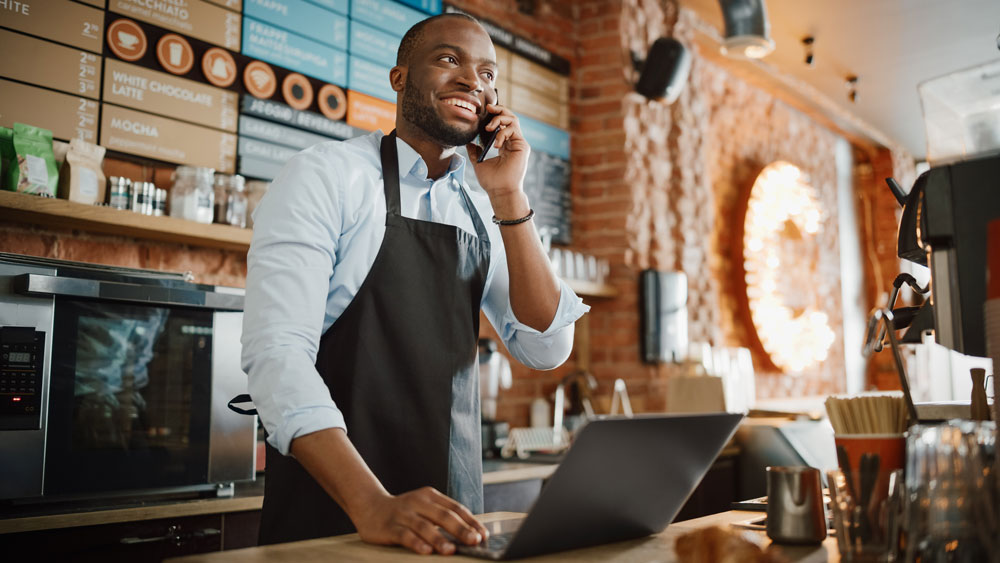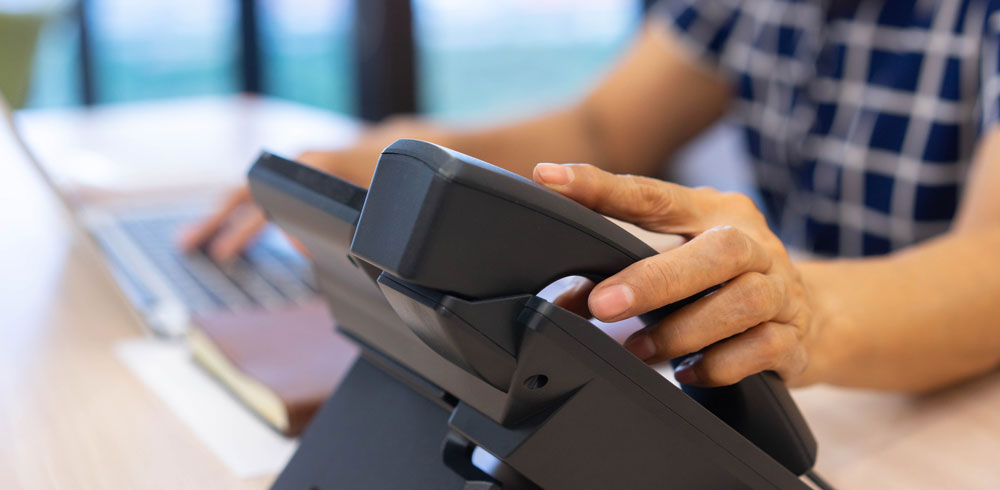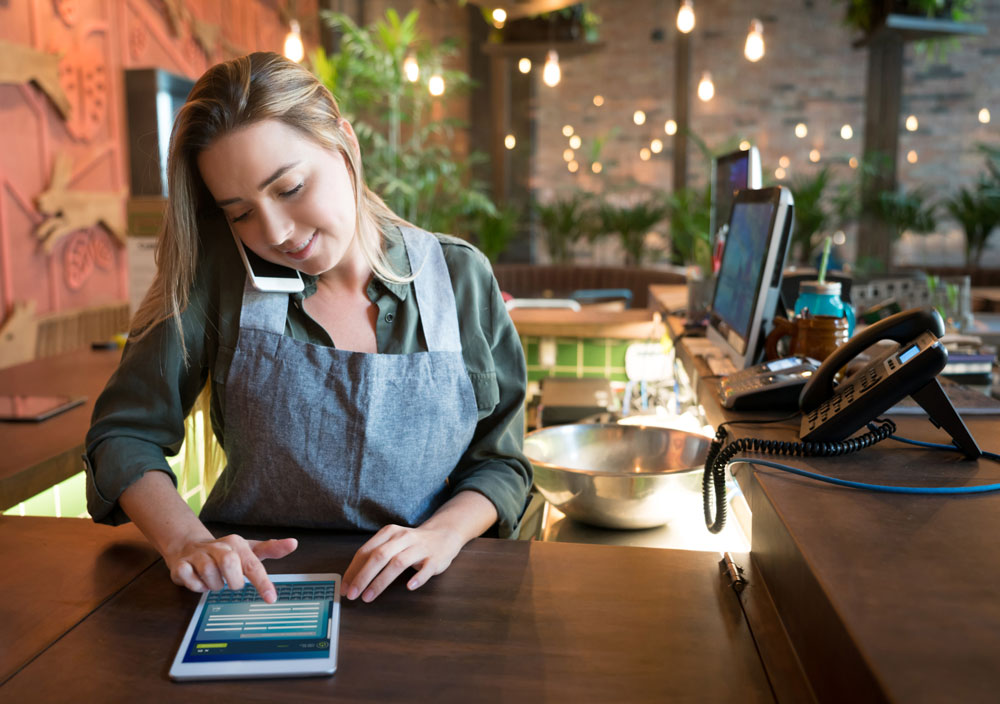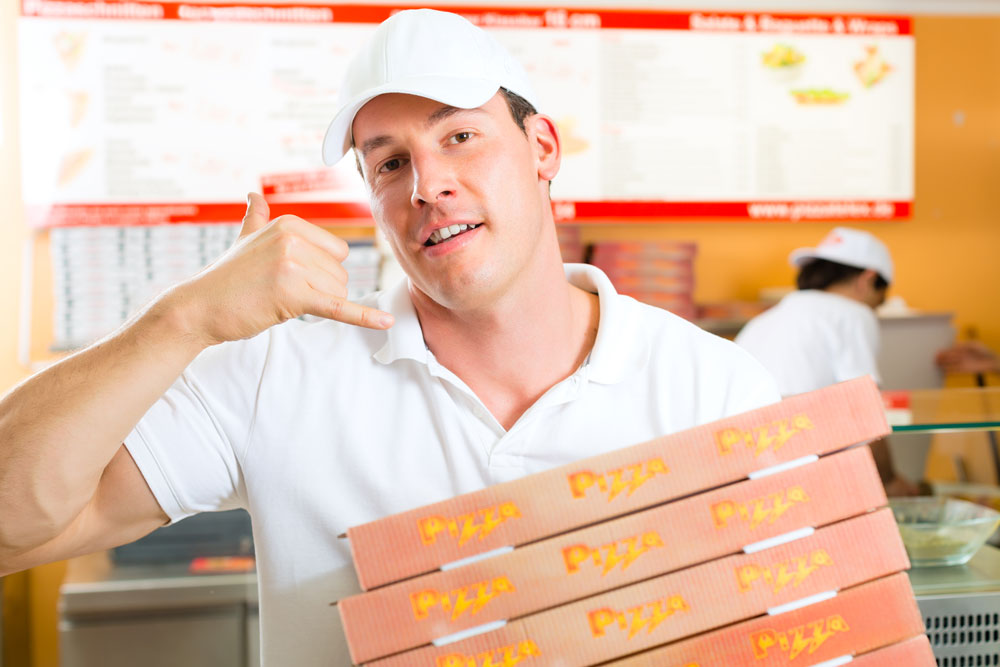- As the demand for delivery continues to rise, restaurant operators are using high-tech phone systems to make it easy for customers to get hold of them.
- Losing phone service when the internet is down loses operators money, so today’s phone systems can come equipped with cellular backup to avoid such a nightmare.
Related: Winning the “game of phones” with call centers for pizzerias
When the pandemic hit in 2020, Shane Switser, owner of The Pizza Man, with two locations in Lyndonville, Vermont, and Jamestown, Kentucky, found his phones ringing off the hook—and his old-fashioned lines weren’t prepared for the onslaught. “We were receiving hundreds of calls a day, on a traditional landline phone from a local provider,” Switser recalls. “If one line was tied up, it rang to the next—but if all four lines were being used, the line would be busy.”
Simultaneously, pandemic-related pivots, such as now-booming curbside service, made reaching The Pizza Man’s employees more important than ever. The solution: installing a VoIP (voice over internet protocol) system with 13 available lines. With this system, Switser had the option of picking up calls with an on-hold message so that customers could press 1 for curbside, 2 for ordering, etc. “We had no choice but to figure out a solution to get a hold of us easier,” Switser explains. “We were able to take a much larger volume of calls, so it had to have made a difference in the bottom line. With the old system, we would have lost thousands in the pandemic.”
Losing the Landlines
Switser’s story underlines the need for a modern-day phone system to handle high volumes of calls at pizzerias. But many experts warn that, soon enough, operators won’t have a choice but to ditch their old “legacy” landlines as companies exchange antiquated copper wires for fiber optics, otherwise known as VoIP. “Carriers like Verizon and AT&T are moving away from landlines, because they don’t make money anymore,” notes Ray Pasquale, CEO and founder of Unified Office in Nashua, New Hampshire. “They’re pulling out copper wires—you almost can’t get a landline today.”
Which begs the question: If phone lines are run by the power of the internet, what happens if the internet goes down? Losing phone service loses operators money, so today’s phone systems can come equipped with cellular backup to avoid such a nightmare. “The router protects the phone and POS system so that you can still accept credit cards and phone orders even if the internet goes down,” explains John Scully, owner of PizzaCloud in Granville, Ohio. “Plus, these types of phones are frequently less expensive than landlines, so you can get great value—including features like call recording, 10 call pads and internet backup, for a low monthly price.”

Related: This study demonstrates why phone etiquette is still important
But are phones still relevant? Though online ordering keeps growing, Scully points out that, on average across the industry, customers are still placing well over 50% of their orders on the phone, while small independents may have only 20% to 30% of their orders placed online. “Having a great phone system is still critical,” Scully stresses. “Even as people transition away from phone ordering, it’ll probably never go away completely. Web ordering has been around for 20 years, and it’s still less than half of all orders.”
Pasquale agrees. “Even at Domino’s, which has spent millions to push people to order online, only 60% to 62% of orders are online-related,” he says. “And the other 40% of orders adds up to a lot of revenue to leave to legacy applications. Plus, our operators—independents and even Domino’s—want to maintain that human connection.”
Cutting Your Losses
Switching to more efficient, updated phone systems offers a bevy of benefits for operators, in addition to money saved and more reliable service. “When I founded Unified Office years ago, VoIP had a bad reputation: dropped calls, audio echo,” Pasquale remembers. “Now, with a solid foundation established, we’ve added services on top to help people make more money and be more productive.”
For example, not only do human phone operators have a greater ability to upsell customers and create higher ticket averages, the phone system itself can sow the seeds of suggestion—even more important amid a labor shortage. Your on-hold message can be created (using your own or the phone company’s “voice talent”) to recommend specials or add-ons to customers. For a bilingual customer base, having them press 2 for service in a second language helps in-store staff determine who can best answer that call.
“With VoIP, you won’t get a busy signal, because the software answers those calls,” Pasquale adds. “In the store, an announcement can tell employees what line to answer next, and a screen monitor can show the success of staff to help them perform better in answering the phones. You pick up orders you were losing before—one pizzeria had a 30% revenue jump after installing new phone lines.” Meanwhile, a phone system can allow for multiunit operators to check on their various locations remotely, pulling up all sites to monitor performance at a glance—with real-time analytics leading to more effective and efficient store management.
In addition, some tools can help with customer satisfaction. “You can perform sentiment analysis across thousands of calls, or record calls in the case of credit card disputes,” Pasquale notes. “You don’t want to go through so many calls manually; the ability to search recordings for a particular phone number makes your job easier.”

Even when the internet goes down, a phone system with cellular backup ensures that your pizzeria won’t miss call-in orders. Photo by Getty Images
Related: Save money by upgrading your restaurant’s phone system
Bespoke Solutions
Since every pizzeria is unique, phone system companies may inquire about your business and its operations to customize a solution that works best for you. Scully asks what features make sense: a random upsell message like “Try our new cheesy breadsticks,” automatic pickup after three rings with a recorded apology for the delay, instructions for curbside orders, or information on sanitation procedures during COVID-19? “Maybe you have catering or party rooms, so you want to add ‘Press 2 to speak to our catering manager,’ then forward those calls to your wife’s cell, because she handles catering,” Scully says. “A company should customize to your needs and make suggestions, but you also know that nothing is carved in stone—if you don’t like the setup, you can change it anytime.”
Scully also suggests finding out if the company you’re working with offers support 24/7, and if a human answers the call when you need assistance. “Some companies stop answering at 5 or 6 p.m., just as a pizzeria is getting into the busiest hours,” Scully notes. “Also, don’t let just the bottom-line price affect your decision; our average customer reports a $500 to $1,000 per month increase in revenue because of special phone features and how they can be used in the pizzeria.”

Therefore, look for a phone system company with pizzeria customers, and don’t be afraid to ask for their expertise on how to set up your phones for the best results—after all, they should be experts in this subject, just like you’re the expert in pizza! “We communicate with all of our customers, asking, ‘What could you use help with?’” Pasquale says. “When the phone company is watching over its customers 24/7, they can see an issue developing and fix it before the pizzeria even realizes there is an issue.” Pasquale also recommends asking if there’s a money-back guarantee, what the term commitment is, and what the penalty would be if that commitment is ended early.
Whatever system you choose, explore the possibilities. For plenty of pizzerias, finding the right phone system has been nothing short of transformative. “Let the system work for you—it’s unlimited in what you can do and how you can configure your phones,” Switser concludes. “Plus, the cellular backup, if the internet goes down, offers so much peace of mind. In the pandemic, we saw our online orders up by 30%, but phone sales were up at least that, or more. Phones are still a big part of what we do. We rely heavily on the phone ringing—that’s the sound of money!”
Last thoughts: Considering call centers
John Scully shares some final thoughts on call centers: Customers with five to six locations might have a small call center with four to six seats, staffed only when it makes sense, like Friday and Saturday dinner hours. It’s more efficient for employees in-store; helps create a better atmosphere in the restaurant, since phones aren’t ringing off the hook; and leads to far fewer errors and higher average tickets through upselling. You can staff call centers yourself or outsource—the latter works better with three to five high-volume locations, or 10 lower-volume locations. Employees can take 30 to 40 orders per hour at call centers, but you can also just have a family member or employee who acts as a ‘call center’ while working from home. However, a call center is not for everybody; it depends on your POS system and the way your business runs. If you’re interested in setting up a call center, have a conversation about it with your phone system company first.















